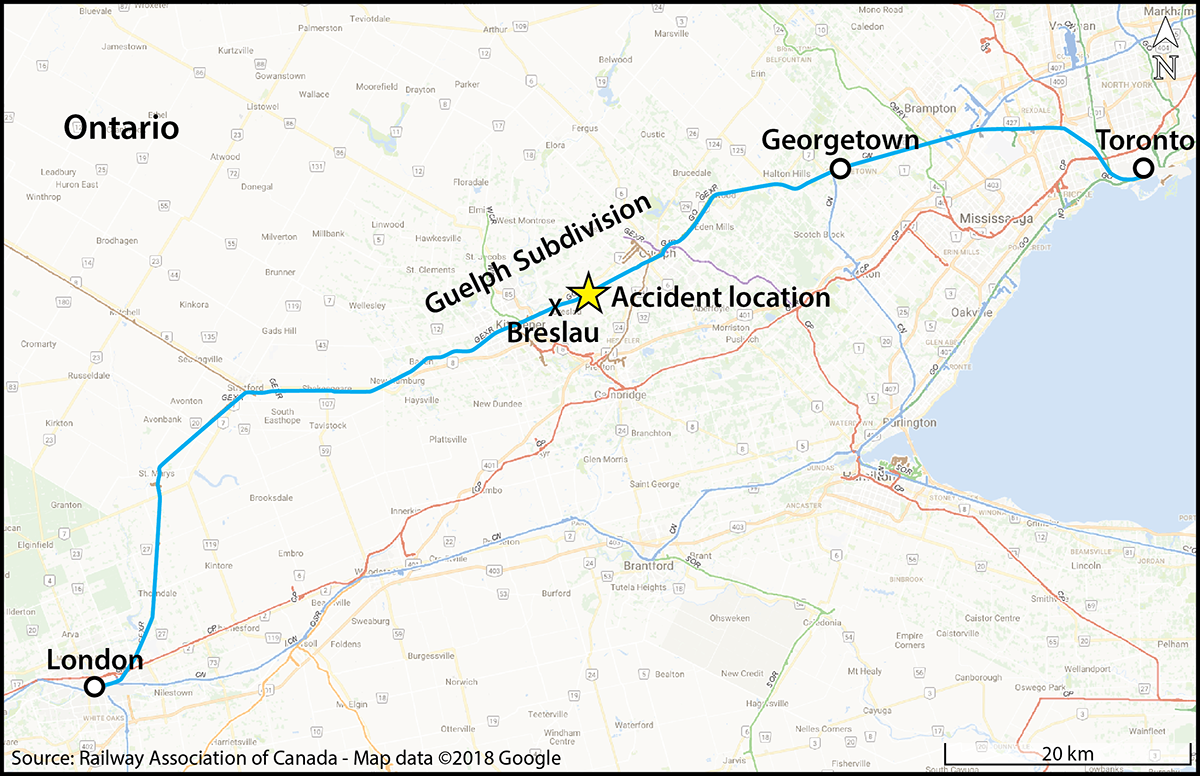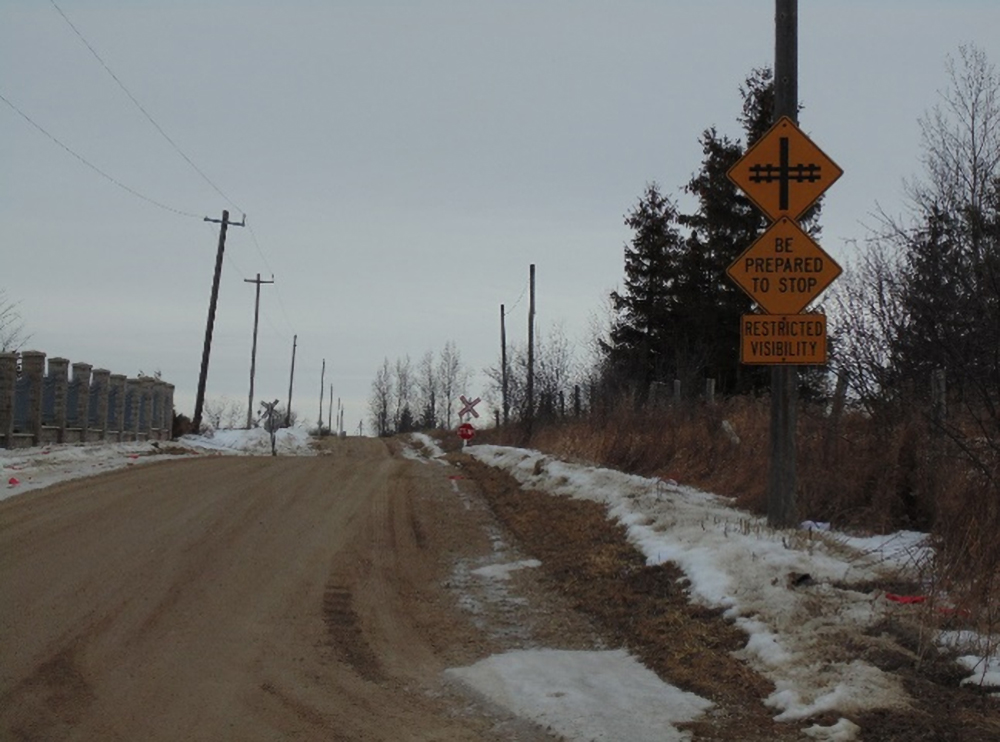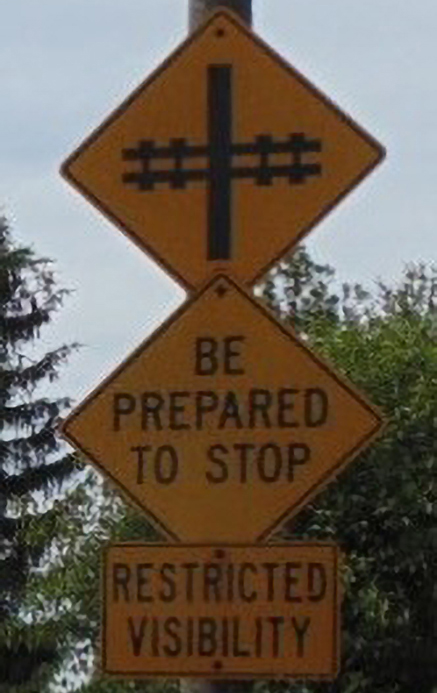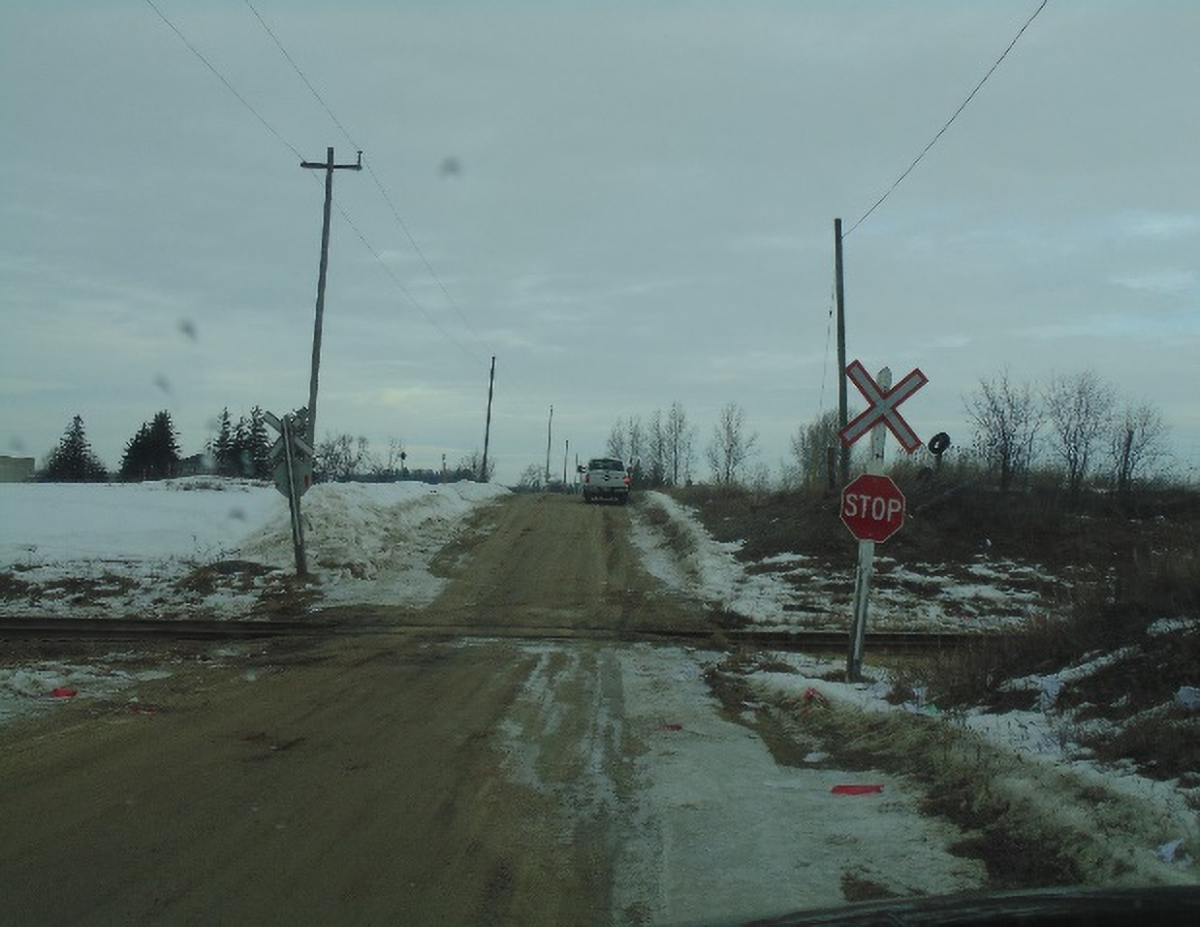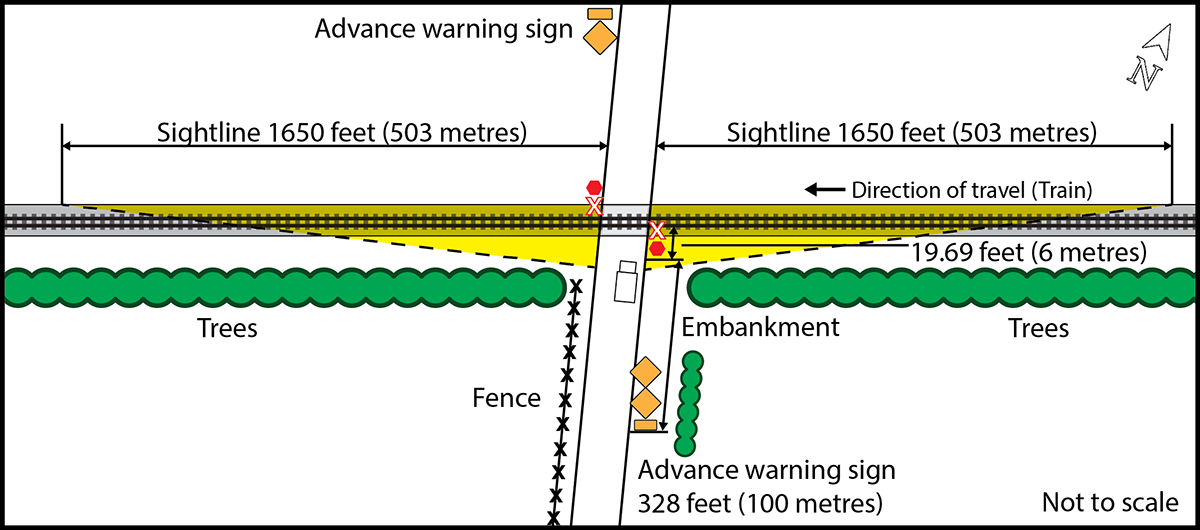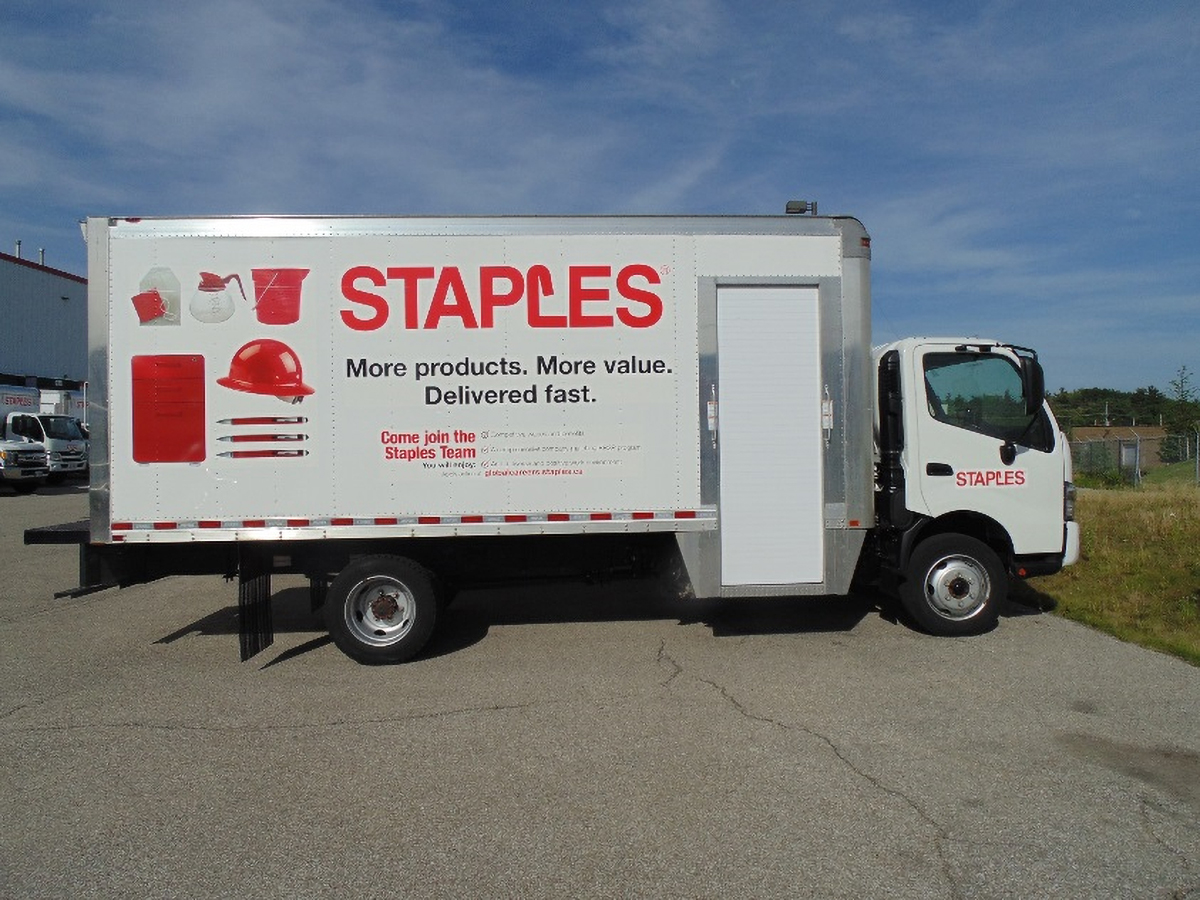Crossing accident
VIA Rail Canada Inc.
Passenger train No. 85
Mile 57, Guelph Subdivision
Breslau, Ontario
The Transportation Safety Board of Canada (TSB) investigated this occurrence for the purpose of advancing transportation safety. It is not the function of the Board to assign fault or determine civil or criminal liability. This report is not created for use in the context of legal, disciplinary or other proceedings. See Ownership and use of content. Masculine pronouns and position titles may be used to signify all genders to comply with the Canadian Transportation Accident Investigation and Safety Board Act (S.C. 1989, c. 3).
The occurrence
On 08 February 2018, at about 1100,Footnote 1 VIA Rail Canada Inc. (VIA) passenger train 85 departed Union Station in Toronto, Ontario, destined for London, Ontario. The train consisted of 1 head-end locomotive and 2 coach cars. It weighed about 252 tons and was about 227 feet long. The train crew comprised an operating locomotive engineer (OLE) and an in-charge locomotive engineer (ICLE). Both crew members were qualified for their respective positions, met rest and fitness standards, and were familiar with the territory. A total of 56 passengers were on board the train.
Shortly after 1200, a Staples Canada Inc. (Staples) delivery truck was travelling southward on Wurster Place, near Breslau, Ontario, to make a delivery to a regular customer at a residence south of the track. En route to this delivery, the truck driver travelled southward over the Wurster Place passive level grade crossing without incident. At about 1228, after completing the delivery, the driver returned northward towards the crossing to make other deliveries.
At about 1230, the train was proceeding westward at 66 mph with its headlights and ditch lights on, in accordance with Canadian Rail Operating Rules (CROR) Rule 17(a) and Rule 19, as it approached the Wurster Place crossing, located at Mile 57.0 of the Guelph SubdivisionFootnote 2 (Figure 1).
As the train approached the crossing, the OLE activated the locomotive horn and bell, in accordance with CROR Rule 13(a)(iv) and Rule 14(l).Footnote 3 At about the same time, the truck approached the crossing from the south at a slow constant speed. The truck, with its windows closed, proceeded onto the crossing without stopping at the stop sign, which was secured to the post of a standard railway crossing sign (SRCS).
At 1230:25, the OLE observed the delivery truck enter the crossing, and immediately initiated an emergency brake application. About 1 second later, the train struck the passenger side of the truck and pushed the truck westward for about 285 feet along the track before the truck came to rest on the south side of the track. About 1 minute later, the train came to a stop; it had travelled about 3150 feet following the emergency brake application. The passengers and the train crew were not injured. The truck was destroyed, and the driver was fatally injured.
Although the train did not derail, the locomotive sustained a damaged air brake line that required repair before it could proceed. The train and passengers were delayed for about 6 hours while VIA arranged for a relief crew to operate the train to its destination.
At the time of the occurrence, the temperature was −9 °C. The skies were overcast, but visibility was good.
Guelph Subdivision and track information
The Guelph Subdivision consists of a single main track that extends from Silver (Mile 30.0), near Georgetown, Ontario, to London, Ontario (Mile 119.1). Train movements on the subdivision are controlled by the centralized traffic control system (CTC), as authorized by the CROR and are supervised by a RailTerm rail traffic controller (RTC) located in Dorval, Quebec, as contracted by the Goderich-Exeter Railway. An average of 14 trains per day operate on the Guelph Subdivision: 8 Metrolinx trains, 4 VIA trains, and 2 Goderich-Exeter Railway freight trains.
In the vicinity of the crossing, the track is rated as Class 4 according to the Transport Canada–approved Rules Respecting Track Safety. The authorized track speed is 55 mph for freight trains and 70 mph for passenger trains.
Regulatory requirements for grade crossings
For roads with lower traffic volumes, public crossings are equipped with reflectorized SRCS secured to wooden posts. Crossings with this type of protection are referred to as public passive crossings. An SCRS is essentially a yield sign, which indicates that drivers must yield the right-of-way to a train. The requirement to yield is also specified in the provincial Highway Traffic Act and the Railway Safety Act. SRCS may also be accompanied by a stop sign on the post or on the roadway approach.
Section 163 of the Ontario Highway Traffic Act outlines the requirements for vehicles to stop at a railway crossing. Subsection 163(2) states the following with regard to stop signs at railway crossings:
(2) Every driver of a vehicle approaching a stop sign at a railway crossing shall, unless otherwise directed by a flagman, stop the vehicle at the marked stop line or, if none, then not less than five metres from the nearest rail of the railway, and shall not proceed until he or she can do so safely.Footnote 4
For vehicles stopped at a passive crossing equipped with a stop sign that traverse a railway track which has a maximum authorized speed of 70 mph, the Transport Canada Grade Crossings Standards (2014) require a minimum sightline of about 1100 feet.Footnote 5
Wurster Place crossing
The accident occurred at the Wurster Place public crossing, which is located about 3 km east of Breslau. Wurster Place is a 2-lane gravel road with a north/south orientation that traverses the railway track at 90 degrees. The Wurster Place road is about 0.8 km long and extends southward from Kramp Road. The road, which provides access to 3 homes and a snowmobile trail, has a maximum posted speed limit of 80 km/h. Daily traffic on this road averages about 56 vehicles.Footnote 6
Advance warning signs are present along the road about 100 m in advance of the crossing in both directions. The advance warning signs inform vehicle drivers that visibility is restricted and to be prepared to stop at the crossing (Figure 2 and Figure 3).
The crossing is equipped with SRCS with stop signs secured to the posts, located about 6 m from the nearest rail on each side of the track (Figure 4).
Sightlines at the Wurster Place crossing
The sightlines at a crossing must allow users to have sufficient time to see an approaching train and to react to it. For crossings equipped with a stop sign, sightlines are measured from the seated driver's position with the vehicle stopped at the stop sign, not less than 5 m from the nearest rail.
At the Wurster Place crossing, vehicles stopped on the south approach to the crossing looking north had sightlines of at least 1650 feet (503 m) to the east and to the west (Figure 5). These sightlines met regulatory requirements.
The driver
The driver had worked for Staples for about 10 years. The driver was a good employee and well liked by colleagues. The driver had had sufficient rest before the shift and was familiar with the route. Toxicology testing determined that the driver was not impaired by drugs or alcohol at the time of the accident.
The truck
The truck was a 2018 cab-over design, manufactured by Hino (Figure 6). It had an odometer reading of about 5000 km and was in new condition. It weighed 14 900 pounds with a lading capacity of 4900 pounds. The forward and peripheral sightlines from within the truck cab were good.
Communications and navigation equipment
A review of the driver's cellphone records revealed that the driver was not actively texting or using his cellphone at the time of the occurrence.
Staples drivers are given a Mobile Proof of Delivery device (MPOD) that is used to obtain electronic sign-off from customers after completing a delivery. However, Staples drivers are trained not to use any handheld devices (including the MPOD) while driving. The MPOD is equipped with a customer departure feature that can be activated by pushing a button on the unit. Once a driver activates the customer departure feature, the MPOD displays the address of the next delivery. The MPOD is also equipped with a global positioning system (GPS), which is used solely to track the location of the delivery truck. The GPS system on the MPOD is not equipped with a navigation display and cannot be used for navigation purposes. In addition, the truck was not equipped with any on-board navigation display.
At the time of the occurrence, the MPOD was stored in its carrying pouch and was not being used. Because the driver was making a regular delivery and knew the route very well, it is unlikely that the driver was using any GPS navigation system at the time.
Effectiveness of locomotive horn
In this occurrence, the truck windows were closed and the driver proceeded onto the crossing without stopping at the stop sign, unaware of the approaching train despite the locomotive horn being activated. However, a number of TSB investigationsFootnote 7 have concluded that the effectiveness of the horn can be compromised due to speed of the train, the dampening of sound through the road vehicle shell and the ambient noise within the vehicle, particularly when the vehicle windows are closed.
Other similar occurrences
On 28 July 2014, another vehicle had been involved in a train collision at the Wurster Place crossing.Footnote 8 In that occurrence, a southbound vehicle had stopped at the north approach of the crossing, but was positioned foul of the track when a westbound VIA passenger train struck the vehicle. The driver of the truck was not injured.
Since 2011, the TSB has investigated 6 crossing collisionsFootnote 9 where the vehicle driver did not approach the crossing prepared to stop, or stop at the crossing as required by the crossing protection in place. These accidents resulted in a total of 12 fatalities and 13 serious injuries.
Safety message
Standard railway crossing signs are yield signs that identify locations where drivers must yield the right-of-way to a train. When approaching a railway level grade crossing, drivers should slow their vehicle and be prepared to stop. If a stop sign is posted at the crossing, all vehicles must stop, and proceed onto the crossing only when it is safe to do so.
This concludes the TSB's limited-scope investigation into this occurrence. The Board authorized the release of this investigation report on . It was officially released on .
